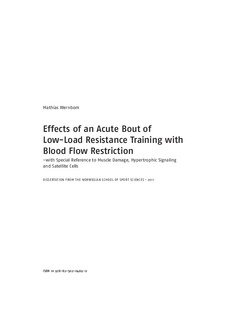| dc.contributor.author | Wernbom, Mathias | |
| dc.date.accessioned | 2011-11-25T07:37:46Z | |
| dc.date.available | 2011-11-25T07:37:46Z | |
| dc.date.issued | 2011 | |
| dc.identifier | Seksjon for fysisk prestasjonsevne / Department of Physical Performance | |
| dc.identifier.isbn | 978-82-502-0469-0 | |
| dc.identifier.uri | http://hdl.handle.net/11250/171330 | |
| dc.description | Avhandling (doktorgrad) - Norges idrettshøgskole, 2011. | no_NO |
| dc.description.abstract | Main findings:
Blood flow restriction reduces muscle endurance at low exercise loads (20-40% of
1RM) but not necessarily at moderate to higher loads (>50% of 1RM) in the knee
extension exercise. The intramuscular pressures in the quadriceps are probably quite
high already at low-to-moderate loads in this exercise, sufficient to induce relative
ischemia as long as the muscle is under tension.
Fatiguing low-load dynamic knee extension exercise both with and without blood flow
restriction induces DOMS.
Fatiguing low-load dynamic knee extension exercise both with and without blood flow
restriction induces high muscle activity in the quadriceps. Not only the concentric but
also the eccentric muscle activity increases as the point of torque failure draws closer.
Very likely, this indicates a high degree of muscle fiber recruitment, possibly also
during eccentric muscle actions.
Multiple sets of low-load resistance exercise to failure with BFR induce decrements in
maximum torque capacity and signs of increased sarcolemmal permeability and
damage at the muscle fiber level. These phenomena were also observed in the freeflow
leg, but to a lesser degree.
Multiple sets of low-load resistance exercise to failure with BFR appear to induce
long-lasting (>24 hours) increases in hypertrophic signaling, and rapid increases in
satellite cell numbers. These phenomena were also observed in the free-flow leg, but
to a somewhat lesser degree with regard to signaling. | en_US |
| dc.description.abstract | Paper I: Wernbom M, Augustsson J, Thomeé R. Effects of vascular occlusion on muscular
endurance in dynamic knee extension exercise at different submaximal loads. J Strength
Cond Res 2006: 20: 372-377. | |
| dc.description.abstract | Paper II: Wernbom M, Järrebring R, Andreasson MA, Augustsson J. Acute effects of blood flow
restriction on muscle activity and endurance during fatiguing dynamic knee extensions at
low load. J Strength Cond Res 2009; 23: 2389-95. | |
| dc.description.abstract | Paper III: Contractile function and sarcolemmal permeability after acute low-load resistance exercise
with blood flow restriction. Manuscript. | |
| dc.description.abstract | Paper IV: Resistance exercise with blood flow restriction increases protein signaling and satellite cell
numbers in human skeletal muscle. Manuscript. | |
| dc.language.iso | eng | no_NO |
| dc.subject | fysiologi | |
| dc.subject | styrketrening | |
| dc.subject | muskler | |
| dc.subject | ischemi | |
| dc.subject | okkulasjonstrening | |
| dc.title | Effects of an acute bout of low-load resistance training with blood flow restriction: -with special reference to muscle damage, hypertrophic signaling and satellite cells | no_NO |
| dc.type | Doctoral thesis | no_NO |
| dc.subject.nsi | VDP::Social science: 200::Social science in sports: 330::Other subjects within physical education: 339 | no_NO |
| dc.subject.nsi | VDP::Mathematics and natural science: 400::Basic biosciences: 470 | no_NO |
